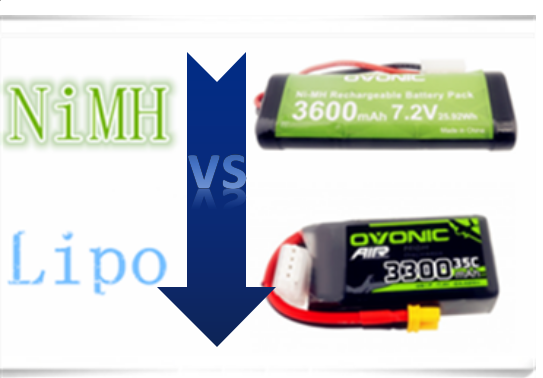
NiMH vs Lipo, What ‘s their pros & cons
In recent years, battery technology has continuously improved and developed. Many high-quality battery types have continuously poured into the market and gradually applied to our lives and work. It is becoming increasingly impossible for people not to use it.

The design of nickel-hydrogen batteries is derived from nickel-cadmium batteries, but there have been great changes in improving the memory effect of nickel-cadmium batteries. The main change is to replace the original cadmium used in the negative electrode with a hydrogen storage alloy, so the nickel-hydrogen battery can be said to be a typical representative of material innovation. Nickel-metal hydride batteries will cause much less pollution than nickel-cadmium batteries containing cadmium. Therefore, nickel-cadmium batteries have gradually been replaced by nickel-hydrogen batteries.
Except for a few lithium batteries that can be used once, most of them have no alternatives to batteries. This is troublesome for long-term overseas trips or a large number of users. Nickel-metal hydride batteries do not have such problems. Digital cameras can often be replaced with alkaline batteries.
As more and more digital cameras use nickel-metal hydride batteries, battery manufacturers are also optimistic about the development prospects of this market, and they have introduced high-capacity nickel-metal hydride rechargeable batteries, which has led to the rapid development of nickel-metal hydride battery technology. The use time has been comparable to that of lithium batteries, and even the charger has become more sophisticated, and the charging time has been greatly reduced.

The lithium polymer battery drives the gearbox with sufficient strength and stability, long battery life, and relatively small volume compared to the above two types of batteries. But you need to pay attention to the use of lithium polymer batteries: the battery must not be over-discharged (the over-discharged here means that the battery voltage should not fall below 3.2v), the lithium polymer battery will swell or fail to charge when over-discharged If this happens, the battery is useless and can no longer be used. In order to detect the capacity of the lithium battery, a voltage alarm is set on the application product. First, the lithium polymer battery has some voltage parameters like 7.4V and 11.1V, then the full-charge display of the 7.4V parameter is about 8.4V; the full-charge display of the 11.1V parameter is about 12.6V. As far as personal experience is concerned, 7.4V can reach 6.70V without any action on the power supply, and it must be taken out for charging, while the 11.1V battery shows 10.20V so that it can be taken out for charging. .
Pros of NiMH batteries
- Resistance to overcharge and over discharge.
- Strong high-speed discharge capability,
- Safe to use, especially under abuse conditions;
- Relatively cheap;
5.High power density
Cons of NiMH rechargeable battery
1.Low voltage
2.Low energy density
Pros of lithium polymer batteries
- The working voltage of the single battery is as high as 3.6v ~ 3.8v, which is much higher than the 1.2V voltage of nickel-hydrogen and nickel-cadmium batteries.
- Large capacity density, its capacity density is 1.5 ~ 2.5 times or higher than that of nickel-metal hydride battery or nickel-cadmium battery.
- The self-discharge is small, and its capacity loss is small after being left for a long time.
4. long life, the normal use of its cycle life can reach more than 500 times.
5, there is no memory effect, there is no need to empty the remaining power before charging, easy to use.
- Good safety performance.
Cons of lithium polymer batteries
- High battery cost and difficult purification of electrolyte system
- Need to protect the control of the circuit. Overcharge or over discharge will damage the reversibility of the chemical substances inside the battery, which will seriously affect the battery life.


Leave a comment